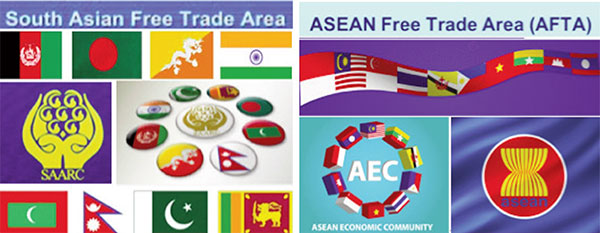Features
Should ASEAN Free Trade Area be considered model for SAFTA?

By Dr. Srimal Fernando
Economic integration is more important today than it has ever been for South Asia’s development. When comparing the impact of South Asian Association for Regional Cooperation (SAARC)s South Asian Free Trade Area (SAFTA) and the Association of Southeast Asian Nations (ASEAN ) Free Trade Area (AFTA) in promoting trade amongst its member states, AFTA has been more effective in integrating the economies of its member states. SAFTA , on the other hand, has yet to make significant contributions to the integration of the economies of SAARC member states. The Success of ASEAN’s economic integration can be attributed to the willingness of Southeast Asian countries to embrace the tenets of regional integration. In contrast, SAARC’s model has failed to create a secure regional environment that is conducive for economic growth since its formation.
The Association of Southeast Asian Nations (ASEAN ) member states signed the AFTA agreement on 28 January 1992. After the establishment of AFTA, the member states of ASEAN succeeded in signing trading protocols within the organization. The ASEAN model succeeded in creating one of the most successful free trade areas in Asia as well as globally. The establishment of AFTA has been an important milestone in Southeast Asia as a factor that facilitated the economic integration of ASEAN member states.
In the case of the SAARC, the signing of free trade protocols under the SAFTA agreement has been faced with several tariff and non-tariff barriers. Although both SASRC and ASEAN member states face unique challenges that affect trading within these organizations, it can be said that, unlike the SAARC, the ASEAN economic integration model has been far successful in promoting trade amongst its member states. For the SAARC, the liberalization of the economies of SAFTA signatories has been a crucial challenge. On the other hand, ASEAN has made notable progress with regards to trade liberalization, policy alignments, and intra-regional trade among Southeast Asian nations.
The specific trade liberalization challenges faced by the SAARC member states include concerns over SAFTA revenue allocation from member states, restrictive rules of origin, and negative sensitive lists. The sensitive lists adopted by SAARC member states have proven to be a significant hurdle to exportation amongst SAARC member states. This has particularly made it difficult for exports from small member states of the SAARC to enter into large markets such as India and Pakistan. Having failed to grant the application of most favored nation (MFN) status that would have seen a significant reduction in the sensitive lists maintained by both countries, trade between these two regional powers has been problematic over the years. Notably, the trading commodities that are in the sensitive lists of a majority of the SAFTA member states have high export potential. Despite the various commitments made by SAFTA member states, countries continue to maintain long sensitive lists hence the dismal performance of SAFTA.
In the case of ASEAN, the establishment of the AFTA agreement has provided ASEAN member states with a platform to exploit their export potential. The AFTA agreement has boosted the economies of ASEAN countries through its trade liberalization policies. AFTA has also entered into several free trade agreements with regional powers such as Australia, China, South Korea, India, and Japan. The ASEAN countries are now focused on creating an Economic Community for their member states. Notably, several countries have shown interest in being a part of the proposed ASEAN Economic Community.
It should however be noted that the massive success achieved by ASEAN’S AFTA as opposed to SAARC’s SAFTA is not flawless. For example, although ASEAN has made significant steps in eliminating tariff barriers amongst AFTA member states, Non-tariff barriers are still a key challenge to the AFTA agreement. However, when analyzing the progress made by ASEAN’s AFTA since its formation, the achievements and evolution are undeniable. ASEAN was formed in an era when interstate relations amongst Southeast Asian countries were characterized by political mistrust and strained interstate relations. Years later, the organization has succeeded in unifying its member states for a common course, an aspect that the SAARC still struggles with.
Way Forward
If SAFTA is to become more effective and emulate AFTA’s success, the myriad of issues mentioned above needs to be addressed. First, downsizing the sensitive lists of countries in a time-bound manner will be necessary. Secondly, the issue of para tariffs needs to be squarely addressed. A starting point could be to reduce and accelerate the elimination of para tariffs on items not on sensitive lists and include para tariffs in SAFTA negotiations. Also, the non-tariff barriers to trade facing SAFTA member states need to be equally addressed like the tariff barriers. Finally, strengthening economic relations can be used to reinforce improving political relations in the region, particularly between India and Pakistan. To an extent, the success of ASEAN in achieving effective economic integration and its experience can be used as an external driver of SAARC and its SAFTA agreement.
About the author:
Dr. Srimal Fernando received his PhD in the area of International Affairs. He was the recipient of the prestigious O.P. Jindal Doctoral Fellowship and SAU Scholarship under the SAARC umbrella. He is also an Advisor/Global Editor of Diplomatic Society for South Africa in partnership with Diplomatic World Institute (Brussels). He has received accolades such as 2018/2019 ‘Best Journalist of the Year’ in South Africa, (GCA) Media Award for 2016 and the Indian Council of World Affairs (ICWA) accolade. He is the author of ‘Politics, Economics and Connectivity: In Search of South Asian Union’